Challenges and Strategies for HRM in Construction Industry Projects
VerifiedAdded on 2021/06/18
|13
|3664
|27
Essay
AI Summary
This essay provides a comprehensive analysis of the key challenges faced by human resource management (HRM) in the construction industry. It begins by highlighting the vital role of HRM, from recruitment and selection to employee retention and performance improvement, emphasizing the industry's reliance on skilled workers and efficient management. The essay delves into specific issues such as recruitment difficulties due to skill shortages and competition, the need for strategic HRM planning, the impact of work-life balance on employee satisfaction, and the importance of managing diversity within the workforce. It also addresses performance management challenges, including low profitability, insufficient investment in research and development, and the need for improved training and career structures. The essay underscores the significance of addressing these challenges to foster a satisfactory work environment and ensure project success. The document is contributed by a student to be published on the website Desklib. Desklib is a platform which provides all the necessary AI based study tools for students.
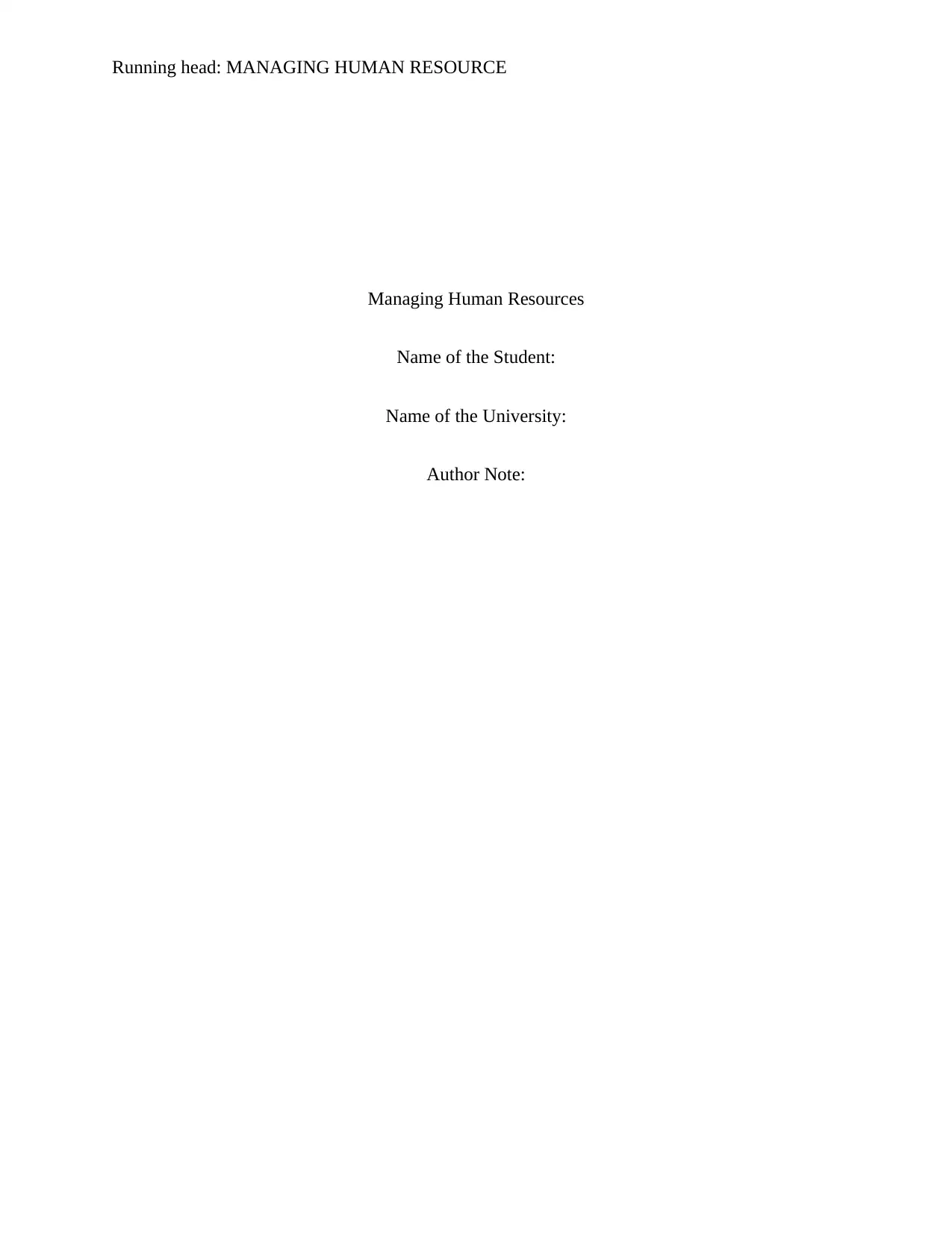
Running head: MANAGING HUMAN RESOURCE
Managing Human Resources
Name of the Student:
Name of the University:
Author Note:
Managing Human Resources
Name of the Student:
Name of the University:
Author Note:
Paraphrase This Document
Need a fresh take? Get an instant paraphrase of this document with our AI Paraphraser
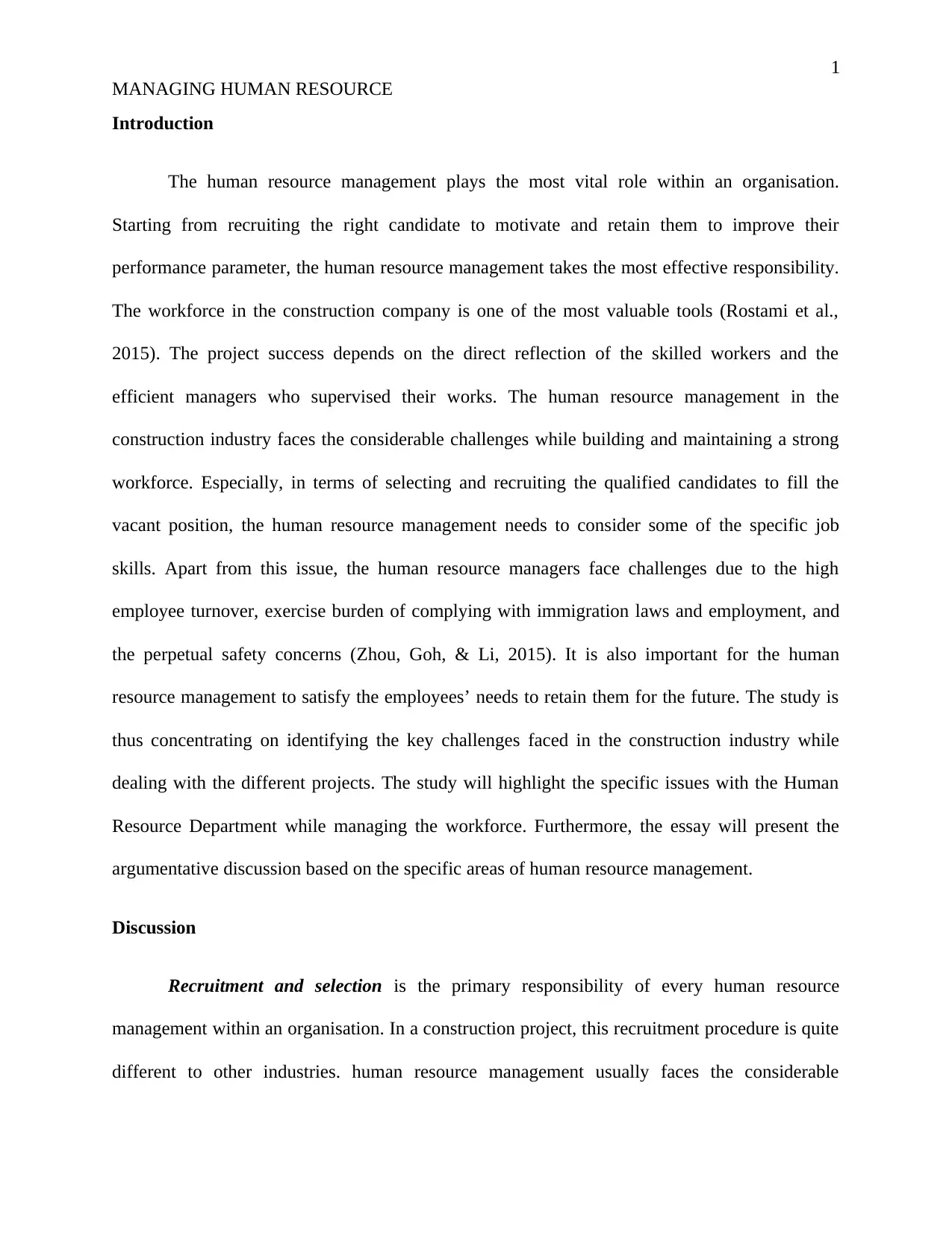
1
MANAGING HUMAN RESOURCE
Introduction
The human resource management plays the most vital role within an organisation.
Starting from recruiting the right candidate to motivate and retain them to improve their
performance parameter, the human resource management takes the most effective responsibility.
The workforce in the construction company is one of the most valuable tools (Rostami et al.,
2015). The project success depends on the direct reflection of the skilled workers and the
efficient managers who supervised their works. The human resource management in the
construction industry faces the considerable challenges while building and maintaining a strong
workforce. Especially, in terms of selecting and recruiting the qualified candidates to fill the
vacant position, the human resource management needs to consider some of the specific job
skills. Apart from this issue, the human resource managers face challenges due to the high
employee turnover, exercise burden of complying with immigration laws and employment, and
the perpetual safety concerns (Zhou, Goh, & Li, 2015). It is also important for the human
resource management to satisfy the employees’ needs to retain them for the future. The study is
thus concentrating on identifying the key challenges faced in the construction industry while
dealing with the different projects. The study will highlight the specific issues with the Human
Resource Department while managing the workforce. Furthermore, the essay will present the
argumentative discussion based on the specific areas of human resource management.
Discussion
Recruitment and selection is the primary responsibility of every human resource
management within an organisation. In a construction project, this recruitment procedure is quite
different to other industries. human resource management usually faces the considerable
MANAGING HUMAN RESOURCE
Introduction
The human resource management plays the most vital role within an organisation.
Starting from recruiting the right candidate to motivate and retain them to improve their
performance parameter, the human resource management takes the most effective responsibility.
The workforce in the construction company is one of the most valuable tools (Rostami et al.,
2015). The project success depends on the direct reflection of the skilled workers and the
efficient managers who supervised their works. The human resource management in the
construction industry faces the considerable challenges while building and maintaining a strong
workforce. Especially, in terms of selecting and recruiting the qualified candidates to fill the
vacant position, the human resource management needs to consider some of the specific job
skills. Apart from this issue, the human resource managers face challenges due to the high
employee turnover, exercise burden of complying with immigration laws and employment, and
the perpetual safety concerns (Zhou, Goh, & Li, 2015). It is also important for the human
resource management to satisfy the employees’ needs to retain them for the future. The study is
thus concentrating on identifying the key challenges faced in the construction industry while
dealing with the different projects. The study will highlight the specific issues with the Human
Resource Department while managing the workforce. Furthermore, the essay will present the
argumentative discussion based on the specific areas of human resource management.
Discussion
Recruitment and selection is the primary responsibility of every human resource
management within an organisation. In a construction project, this recruitment procedure is quite
different to other industries. human resource management usually faces the considerable
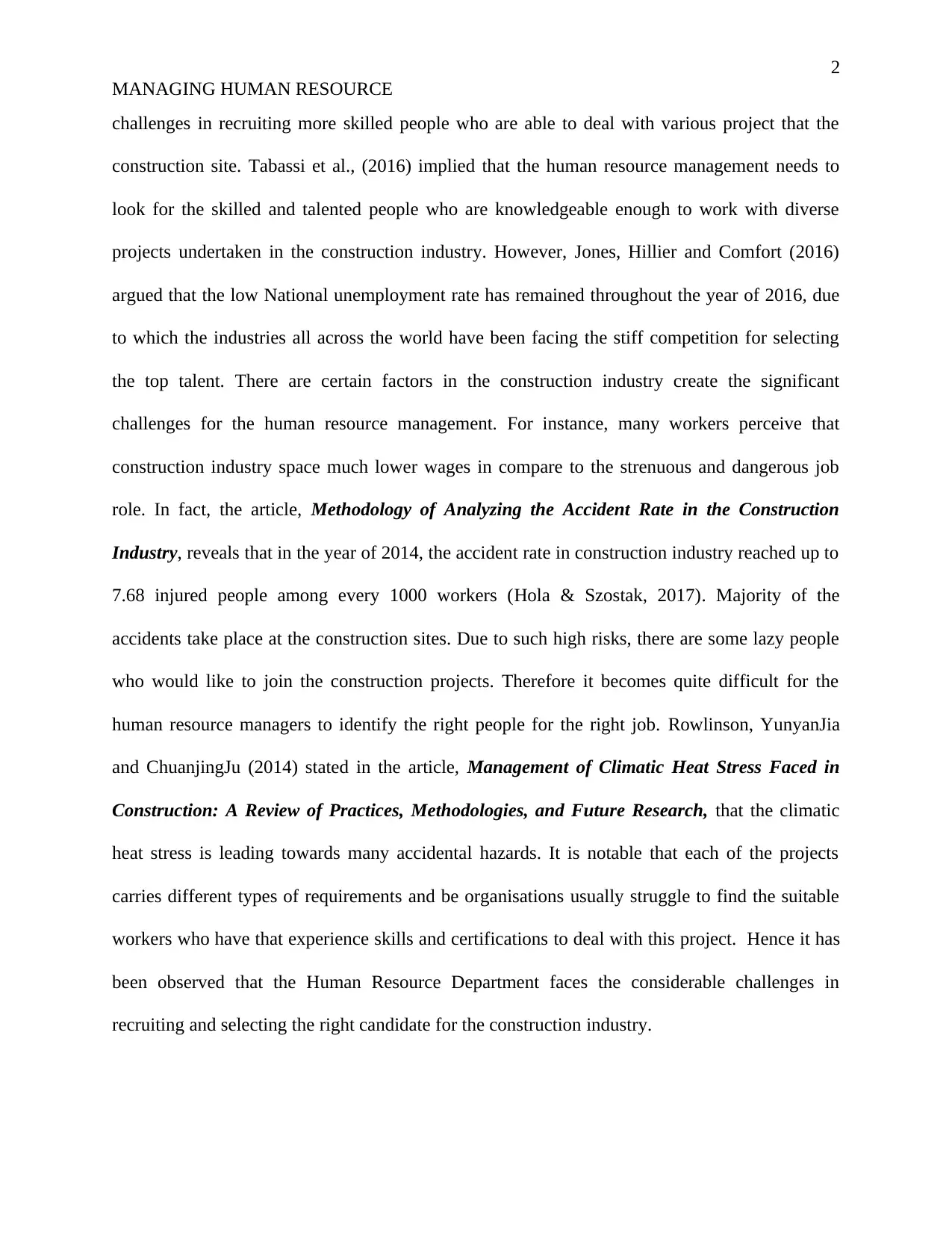
2
MANAGING HUMAN RESOURCE
challenges in recruiting more skilled people who are able to deal with various project that the
construction site. Tabassi et al., (2016) implied that the human resource management needs to
look for the skilled and talented people who are knowledgeable enough to work with diverse
projects undertaken in the construction industry. However, Jones, Hillier and Comfort (2016)
argued that the low National unemployment rate has remained throughout the year of 2016, due
to which the industries all across the world have been facing the stiff competition for selecting
the top talent. There are certain factors in the construction industry create the significant
challenges for the human resource management. For instance, many workers perceive that
construction industry space much lower wages in compare to the strenuous and dangerous job
role. In fact, the article, Methodology of Analyzing the Accident Rate in the Construction
Industry, reveals that in the year of 2014, the accident rate in construction industry reached up to
7.68 injured people among every 1000 workers (Hola & Szostak, 2017). Majority of the
accidents take place at the construction sites. Due to such high risks, there are some lazy people
who would like to join the construction projects. Therefore it becomes quite difficult for the
human resource managers to identify the right people for the right job. Rowlinson, YunyanJia
and ChuanjingJu (2014) stated in the article, Management of Climatic Heat Stress Faced in
Construction: A Review of Practices, Methodologies, and Future Research, that the climatic
heat stress is leading towards many accidental hazards. It is notable that each of the projects
carries different types of requirements and be organisations usually struggle to find the suitable
workers who have that experience skills and certifications to deal with this project. Hence it has
been observed that the Human Resource Department faces the considerable challenges in
recruiting and selecting the right candidate for the construction industry.
MANAGING HUMAN RESOURCE
challenges in recruiting more skilled people who are able to deal with various project that the
construction site. Tabassi et al., (2016) implied that the human resource management needs to
look for the skilled and talented people who are knowledgeable enough to work with diverse
projects undertaken in the construction industry. However, Jones, Hillier and Comfort (2016)
argued that the low National unemployment rate has remained throughout the year of 2016, due
to which the industries all across the world have been facing the stiff competition for selecting
the top talent. There are certain factors in the construction industry create the significant
challenges for the human resource management. For instance, many workers perceive that
construction industry space much lower wages in compare to the strenuous and dangerous job
role. In fact, the article, Methodology of Analyzing the Accident Rate in the Construction
Industry, reveals that in the year of 2014, the accident rate in construction industry reached up to
7.68 injured people among every 1000 workers (Hola & Szostak, 2017). Majority of the
accidents take place at the construction sites. Due to such high risks, there are some lazy people
who would like to join the construction projects. Therefore it becomes quite difficult for the
human resource managers to identify the right people for the right job. Rowlinson, YunyanJia
and ChuanjingJu (2014) stated in the article, Management of Climatic Heat Stress Faced in
Construction: A Review of Practices, Methodologies, and Future Research, that the climatic
heat stress is leading towards many accidental hazards. It is notable that each of the projects
carries different types of requirements and be organisations usually struggle to find the suitable
workers who have that experience skills and certifications to deal with this project. Hence it has
been observed that the Human Resource Department faces the considerable challenges in
recruiting and selecting the right candidate for the construction industry.
⊘ This is a preview!⊘
Do you want full access?
Subscribe today to unlock all pages.

Trusted by 1+ million students worldwide
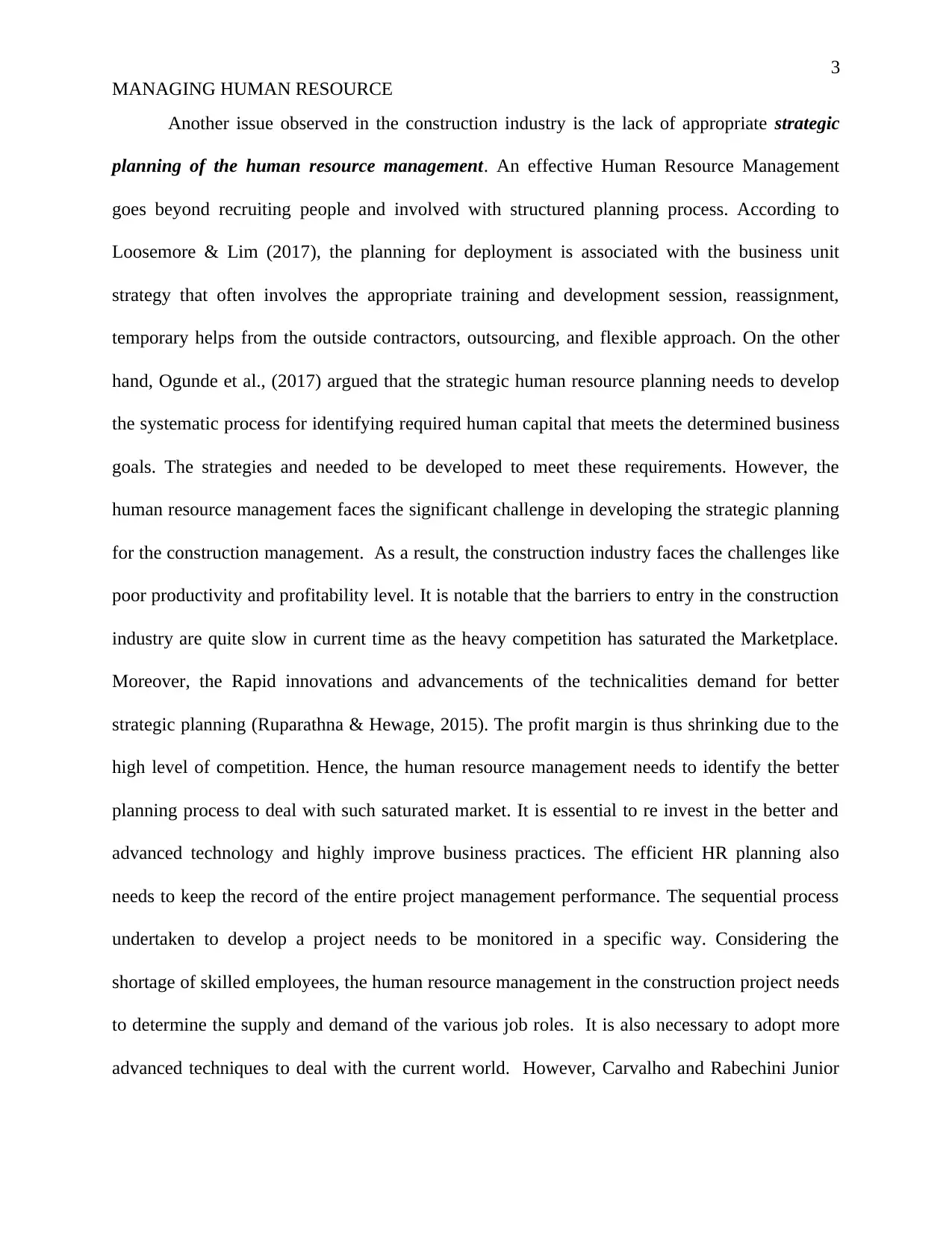
3
MANAGING HUMAN RESOURCE
Another issue observed in the construction industry is the lack of appropriate strategic
planning of the human resource management. An effective Human Resource Management
goes beyond recruiting people and involved with structured planning process. According to
Loosemore & Lim (2017), the planning for deployment is associated with the business unit
strategy that often involves the appropriate training and development session, reassignment,
temporary helps from the outside contractors, outsourcing, and flexible approach. On the other
hand, Ogunde et al., (2017) argued that the strategic human resource planning needs to develop
the systematic process for identifying required human capital that meets the determined business
goals. The strategies and needed to be developed to meet these requirements. However, the
human resource management faces the significant challenge in developing the strategic planning
for the construction management. As a result, the construction industry faces the challenges like
poor productivity and profitability level. It is notable that the barriers to entry in the construction
industry are quite slow in current time as the heavy competition has saturated the Marketplace.
Moreover, the Rapid innovations and advancements of the technicalities demand for better
strategic planning (Ruparathna & Hewage, 2015). The profit margin is thus shrinking due to the
high level of competition. Hence, the human resource management needs to identify the better
planning process to deal with such saturated market. It is essential to re invest in the better and
advanced technology and highly improve business practices. The efficient HR planning also
needs to keep the record of the entire project management performance. The sequential process
undertaken to develop a project needs to be monitored in a specific way. Considering the
shortage of skilled employees, the human resource management in the construction project needs
to determine the supply and demand of the various job roles. It is also necessary to adopt more
advanced techniques to deal with the current world. However, Carvalho and Rabechini Junior
MANAGING HUMAN RESOURCE
Another issue observed in the construction industry is the lack of appropriate strategic
planning of the human resource management. An effective Human Resource Management
goes beyond recruiting people and involved with structured planning process. According to
Loosemore & Lim (2017), the planning for deployment is associated with the business unit
strategy that often involves the appropriate training and development session, reassignment,
temporary helps from the outside contractors, outsourcing, and flexible approach. On the other
hand, Ogunde et al., (2017) argued that the strategic human resource planning needs to develop
the systematic process for identifying required human capital that meets the determined business
goals. The strategies and needed to be developed to meet these requirements. However, the
human resource management faces the significant challenge in developing the strategic planning
for the construction management. As a result, the construction industry faces the challenges like
poor productivity and profitability level. It is notable that the barriers to entry in the construction
industry are quite slow in current time as the heavy competition has saturated the Marketplace.
Moreover, the Rapid innovations and advancements of the technicalities demand for better
strategic planning (Ruparathna & Hewage, 2015). The profit margin is thus shrinking due to the
high level of competition. Hence, the human resource management needs to identify the better
planning process to deal with such saturated market. It is essential to re invest in the better and
advanced technology and highly improve business practices. The efficient HR planning also
needs to keep the record of the entire project management performance. The sequential process
undertaken to develop a project needs to be monitored in a specific way. Considering the
shortage of skilled employees, the human resource management in the construction project needs
to determine the supply and demand of the various job roles. It is also necessary to adopt more
advanced techniques to deal with the current world. However, Carvalho and Rabechini Junior
Paraphrase This Document
Need a fresh take? Get an instant paraphrase of this document with our AI Paraphraser
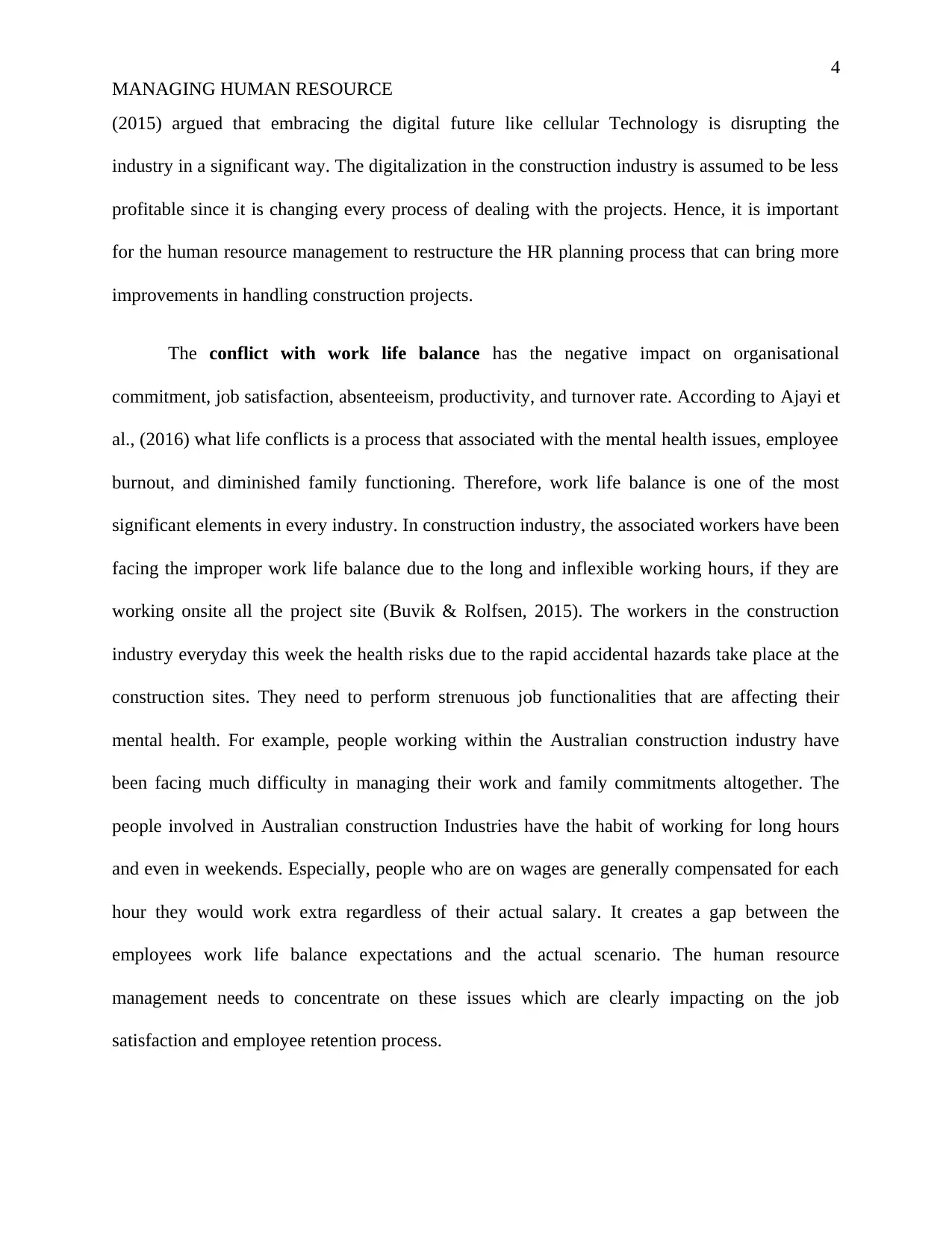
4
MANAGING HUMAN RESOURCE
(2015) argued that embracing the digital future like cellular Technology is disrupting the
industry in a significant way. The digitalization in the construction industry is assumed to be less
profitable since it is changing every process of dealing with the projects. Hence, it is important
for the human resource management to restructure the HR planning process that can bring more
improvements in handling construction projects.
The conflict with work life balance has the negative impact on organisational
commitment, job satisfaction, absenteeism, productivity, and turnover rate. According to Ajayi et
al., (2016) what life conflicts is a process that associated with the mental health issues, employee
burnout, and diminished family functioning. Therefore, work life balance is one of the most
significant elements in every industry. In construction industry, the associated workers have been
facing the improper work life balance due to the long and inflexible working hours, if they are
working onsite all the project site (Buvik & Rolfsen, 2015). The workers in the construction
industry everyday this week the health risks due to the rapid accidental hazards take place at the
construction sites. They need to perform strenuous job functionalities that are affecting their
mental health. For example, people working within the Australian construction industry have
been facing much difficulty in managing their work and family commitments altogether. The
people involved in Australian construction Industries have the habit of working for long hours
and even in weekends. Especially, people who are on wages are generally compensated for each
hour they would work extra regardless of their actual salary. It creates a gap between the
employees work life balance expectations and the actual scenario. The human resource
management needs to concentrate on these issues which are clearly impacting on the job
satisfaction and employee retention process.
MANAGING HUMAN RESOURCE
(2015) argued that embracing the digital future like cellular Technology is disrupting the
industry in a significant way. The digitalization in the construction industry is assumed to be less
profitable since it is changing every process of dealing with the projects. Hence, it is important
for the human resource management to restructure the HR planning process that can bring more
improvements in handling construction projects.
The conflict with work life balance has the negative impact on organisational
commitment, job satisfaction, absenteeism, productivity, and turnover rate. According to Ajayi et
al., (2016) what life conflicts is a process that associated with the mental health issues, employee
burnout, and diminished family functioning. Therefore, work life balance is one of the most
significant elements in every industry. In construction industry, the associated workers have been
facing the improper work life balance due to the long and inflexible working hours, if they are
working onsite all the project site (Buvik & Rolfsen, 2015). The workers in the construction
industry everyday this week the health risks due to the rapid accidental hazards take place at the
construction sites. They need to perform strenuous job functionalities that are affecting their
mental health. For example, people working within the Australian construction industry have
been facing much difficulty in managing their work and family commitments altogether. The
people involved in Australian construction Industries have the habit of working for long hours
and even in weekends. Especially, people who are on wages are generally compensated for each
hour they would work extra regardless of their actual salary. It creates a gap between the
employees work life balance expectations and the actual scenario. The human resource
management needs to concentrate on these issues which are clearly impacting on the job
satisfaction and employee retention process.
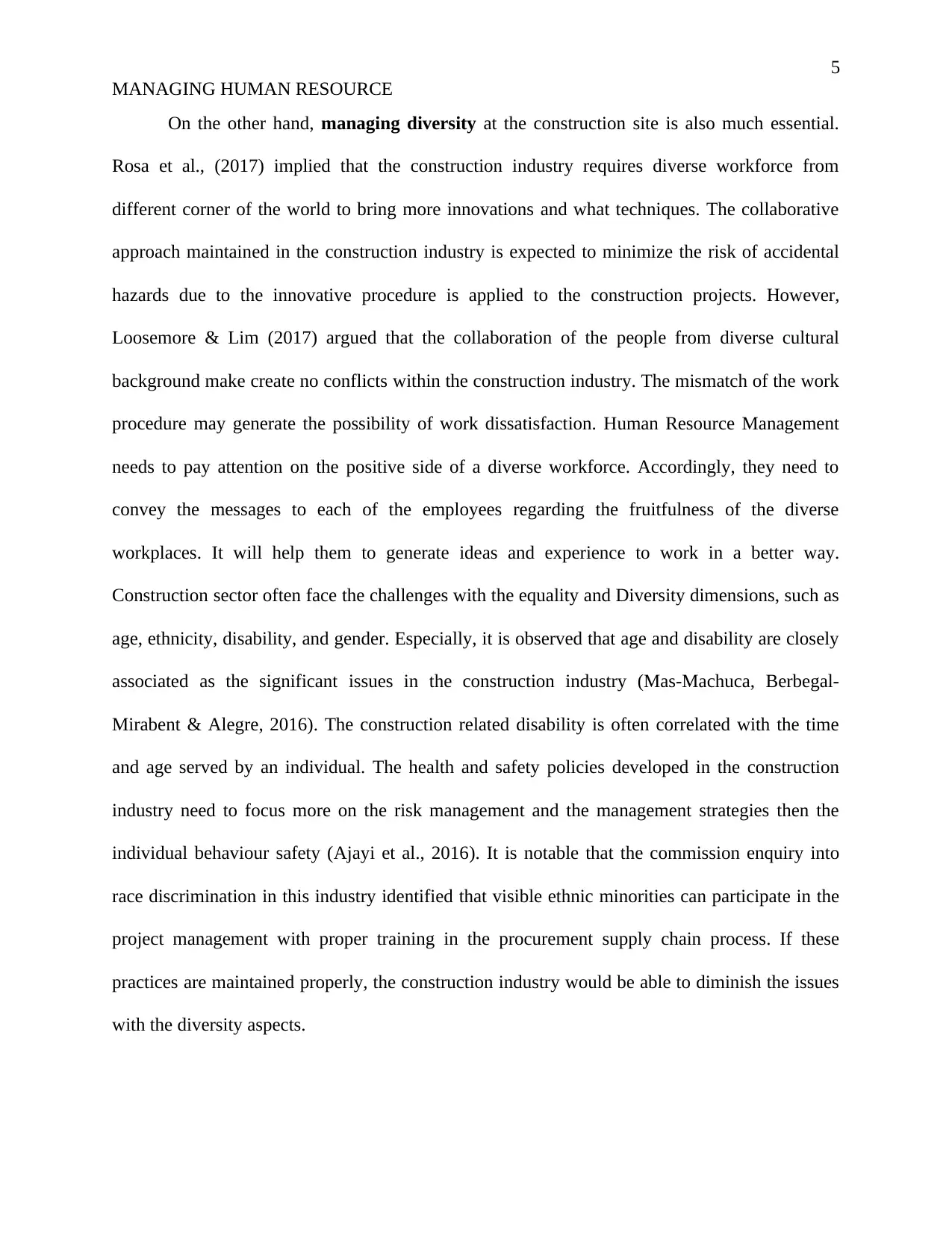
5
MANAGING HUMAN RESOURCE
On the other hand, managing diversity at the construction site is also much essential.
Rosa et al., (2017) implied that the construction industry requires diverse workforce from
different corner of the world to bring more innovations and what techniques. The collaborative
approach maintained in the construction industry is expected to minimize the risk of accidental
hazards due to the innovative procedure is applied to the construction projects. However,
Loosemore & Lim (2017) argued that the collaboration of the people from diverse cultural
background make create no conflicts within the construction industry. The mismatch of the work
procedure may generate the possibility of work dissatisfaction. Human Resource Management
needs to pay attention on the positive side of a diverse workforce. Accordingly, they need to
convey the messages to each of the employees regarding the fruitfulness of the diverse
workplaces. It will help them to generate ideas and experience to work in a better way.
Construction sector often face the challenges with the equality and Diversity dimensions, such as
age, ethnicity, disability, and gender. Especially, it is observed that age and disability are closely
associated as the significant issues in the construction industry (Mas-Machuca, Berbegal-
Mirabent & Alegre, 2016). The construction related disability is often correlated with the time
and age served by an individual. The health and safety policies developed in the construction
industry need to focus more on the risk management and the management strategies then the
individual behaviour safety (Ajayi et al., 2016). It is notable that the commission enquiry into
race discrimination in this industry identified that visible ethnic minorities can participate in the
project management with proper training in the procurement supply chain process. If these
practices are maintained properly, the construction industry would be able to diminish the issues
with the diversity aspects.
MANAGING HUMAN RESOURCE
On the other hand, managing diversity at the construction site is also much essential.
Rosa et al., (2017) implied that the construction industry requires diverse workforce from
different corner of the world to bring more innovations and what techniques. The collaborative
approach maintained in the construction industry is expected to minimize the risk of accidental
hazards due to the innovative procedure is applied to the construction projects. However,
Loosemore & Lim (2017) argued that the collaboration of the people from diverse cultural
background make create no conflicts within the construction industry. The mismatch of the work
procedure may generate the possibility of work dissatisfaction. Human Resource Management
needs to pay attention on the positive side of a diverse workforce. Accordingly, they need to
convey the messages to each of the employees regarding the fruitfulness of the diverse
workplaces. It will help them to generate ideas and experience to work in a better way.
Construction sector often face the challenges with the equality and Diversity dimensions, such as
age, ethnicity, disability, and gender. Especially, it is observed that age and disability are closely
associated as the significant issues in the construction industry (Mas-Machuca, Berbegal-
Mirabent & Alegre, 2016). The construction related disability is often correlated with the time
and age served by an individual. The health and safety policies developed in the construction
industry need to focus more on the risk management and the management strategies then the
individual behaviour safety (Ajayi et al., 2016). It is notable that the commission enquiry into
race discrimination in this industry identified that visible ethnic minorities can participate in the
project management with proper training in the procurement supply chain process. If these
practices are maintained properly, the construction industry would be able to diminish the issues
with the diversity aspects.
⊘ This is a preview!⊘
Do you want full access?
Subscribe today to unlock all pages.

Trusted by 1+ million students worldwide

6
MANAGING HUMAN RESOURCE
The construction projects are generally organized to perform the complex tasks that will
be completed by multidisciplinary teams associated with this industry. Cappelli (2015) implied
that the performance management is conceptualized as the systematic process of identifying,
developing, measuring, and monitoring performance by observing the individual objectives. In
the construction industry, the performance management is based on the three basic factors, such
as the technical success, performance on budget, and performance on project schedule. The
manager needs to take the responsibility to adopt the fruitful performance management practices
that are facilitating the rapid monitoring, review, and ongoing development of the departmental
objectives. The performance management in the construction industry is based on five criteria,
such as organisational strategy, Individual behaviour, individual attribute, situational
constraints, and objective results (Langford et al., 2014). Managing these aspects to measure the
performance parameter determines the project success in a significant way. It is noticed that the
construction industry is quite aware of the necessity of modernizing the technicalities in
operating in a volatile business market. However, the human resource management faces the
considerable challenges in some of the definite areas. First, the low and unreliable profitability
rate in the performance management is creating the obstacle in performance management
(Ajayi et al., 2016). The construction companies experience the lower margin for sustaining the
healthy development. Second, if the capital investment in the research and development is too
low, the construction industry may face trouble in developing innovations in the technological
and functional areas. Third, the construction industry may face trouble in developing the
appropriate training process. It is already stated that the construction industry has been facing the
ongoing concerns regarding the shortage of skilled workers. Rowlinson, YunyanJia and
ChuanjingJu (2014) identified that a lesser number of people are receiving the proper training to
MANAGING HUMAN RESOURCE
The construction projects are generally organized to perform the complex tasks that will
be completed by multidisciplinary teams associated with this industry. Cappelli (2015) implied
that the performance management is conceptualized as the systematic process of identifying,
developing, measuring, and monitoring performance by observing the individual objectives. In
the construction industry, the performance management is based on the three basic factors, such
as the technical success, performance on budget, and performance on project schedule. The
manager needs to take the responsibility to adopt the fruitful performance management practices
that are facilitating the rapid monitoring, review, and ongoing development of the departmental
objectives. The performance management in the construction industry is based on five criteria,
such as organisational strategy, Individual behaviour, individual attribute, situational
constraints, and objective results (Langford et al., 2014). Managing these aspects to measure the
performance parameter determines the project success in a significant way. It is noticed that the
construction industry is quite aware of the necessity of modernizing the technicalities in
operating in a volatile business market. However, the human resource management faces the
considerable challenges in some of the definite areas. First, the low and unreliable profitability
rate in the performance management is creating the obstacle in performance management
(Ajayi et al., 2016). The construction companies experience the lower margin for sustaining the
healthy development. Second, if the capital investment in the research and development is too
low, the construction industry may face trouble in developing innovations in the technological
and functional areas. Third, the construction industry may face trouble in developing the
appropriate training process. It is already stated that the construction industry has been facing the
ongoing concerns regarding the shortage of skilled workers. Rowlinson, YunyanJia and
ChuanjingJu (2014) identified that a lesser number of people are receiving the proper training to
Paraphrase This Document
Need a fresh take? Get an instant paraphrase of this document with our AI Paraphraser
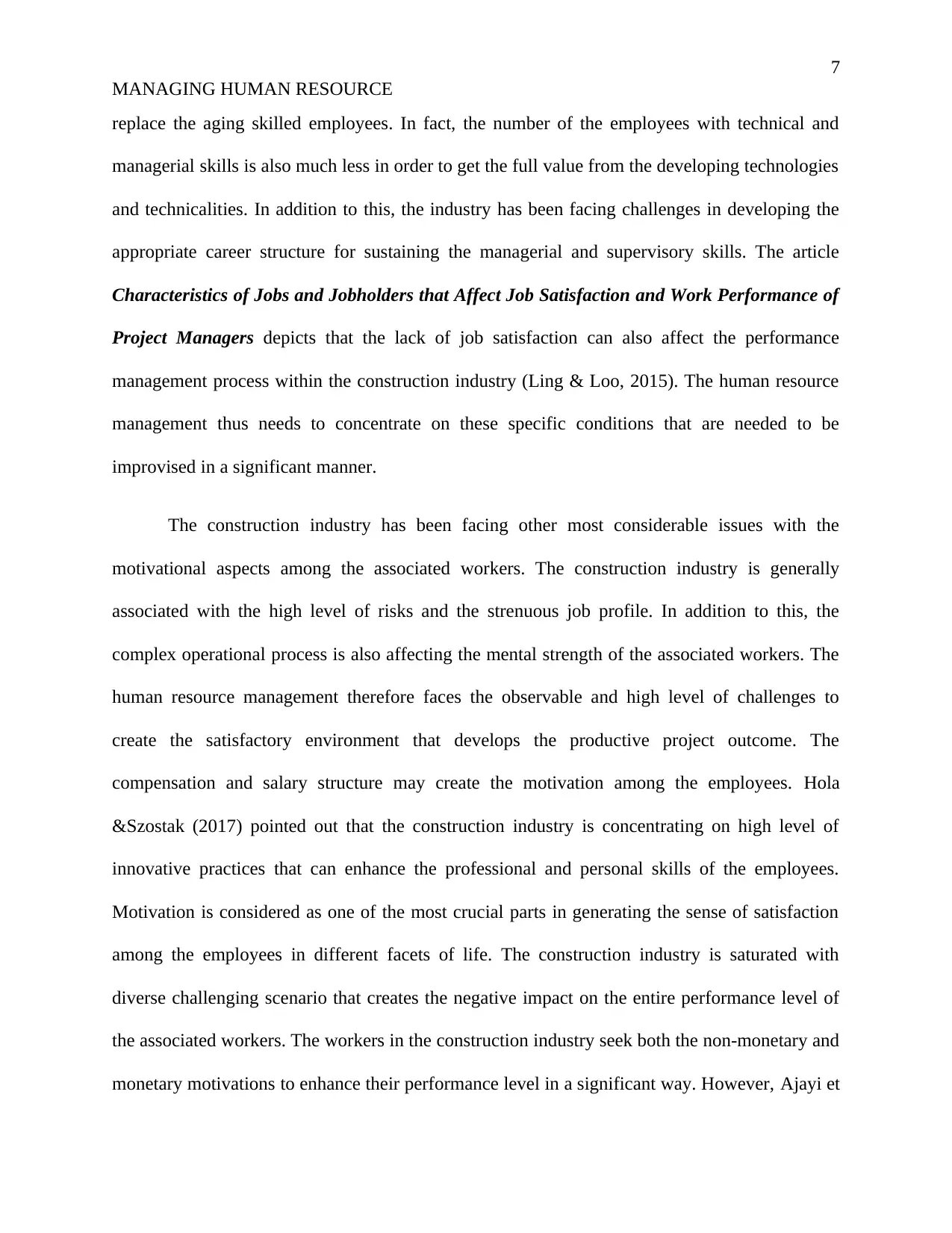
7
MANAGING HUMAN RESOURCE
replace the aging skilled employees. In fact, the number of the employees with technical and
managerial skills is also much less in order to get the full value from the developing technologies
and technicalities. In addition to this, the industry has been facing challenges in developing the
appropriate career structure for sustaining the managerial and supervisory skills. The article
Characteristics of Jobs and Jobholders that Affect Job Satisfaction and Work Performance of
Project Managers depicts that the lack of job satisfaction can also affect the performance
management process within the construction industry (Ling & Loo, 2015). The human resource
management thus needs to concentrate on these specific conditions that are needed to be
improvised in a significant manner.
The construction industry has been facing other most considerable issues with the
motivational aspects among the associated workers. The construction industry is generally
associated with the high level of risks and the strenuous job profile. In addition to this, the
complex operational process is also affecting the mental strength of the associated workers. The
human resource management therefore faces the observable and high level of challenges to
create the satisfactory environment that develops the productive project outcome. The
compensation and salary structure may create the motivation among the employees. Hola
&Szostak (2017) pointed out that the construction industry is concentrating on high level of
innovative practices that can enhance the professional and personal skills of the employees.
Motivation is considered as one of the most crucial parts in generating the sense of satisfaction
among the employees in different facets of life. The construction industry is saturated with
diverse challenging scenario that creates the negative impact on the entire performance level of
the associated workers. The workers in the construction industry seek both the non-monetary and
monetary motivations to enhance their performance level in a significant way. However, Ajayi et
MANAGING HUMAN RESOURCE
replace the aging skilled employees. In fact, the number of the employees with technical and
managerial skills is also much less in order to get the full value from the developing technologies
and technicalities. In addition to this, the industry has been facing challenges in developing the
appropriate career structure for sustaining the managerial and supervisory skills. The article
Characteristics of Jobs and Jobholders that Affect Job Satisfaction and Work Performance of
Project Managers depicts that the lack of job satisfaction can also affect the performance
management process within the construction industry (Ling & Loo, 2015). The human resource
management thus needs to concentrate on these specific conditions that are needed to be
improvised in a significant manner.
The construction industry has been facing other most considerable issues with the
motivational aspects among the associated workers. The construction industry is generally
associated with the high level of risks and the strenuous job profile. In addition to this, the
complex operational process is also affecting the mental strength of the associated workers. The
human resource management therefore faces the observable and high level of challenges to
create the satisfactory environment that develops the productive project outcome. The
compensation and salary structure may create the motivation among the employees. Hola
&Szostak (2017) pointed out that the construction industry is concentrating on high level of
innovative practices that can enhance the professional and personal skills of the employees.
Motivation is considered as one of the most crucial parts in generating the sense of satisfaction
among the employees in different facets of life. The construction industry is saturated with
diverse challenging scenario that creates the negative impact on the entire performance level of
the associated workers. The workers in the construction industry seek both the non-monetary and
monetary motivations to enhance their performance level in a significant way. However, Ajayi et
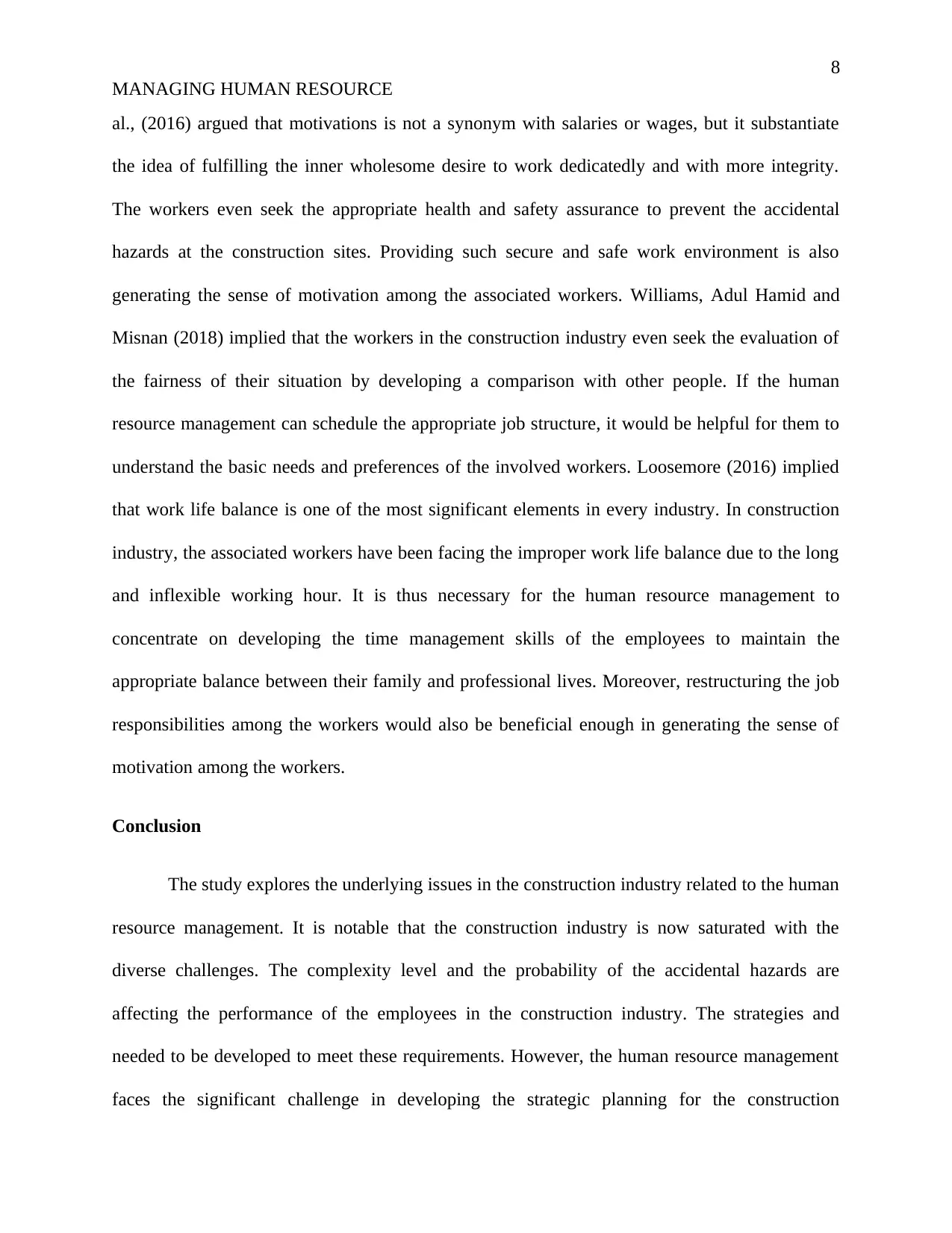
8
MANAGING HUMAN RESOURCE
al., (2016) argued that motivations is not a synonym with salaries or wages, but it substantiate
the idea of fulfilling the inner wholesome desire to work dedicatedly and with more integrity.
The workers even seek the appropriate health and safety assurance to prevent the accidental
hazards at the construction sites. Providing such secure and safe work environment is also
generating the sense of motivation among the associated workers. Williams, Adul Hamid and
Misnan (2018) implied that the workers in the construction industry even seek the evaluation of
the fairness of their situation by developing a comparison with other people. If the human
resource management can schedule the appropriate job structure, it would be helpful for them to
understand the basic needs and preferences of the involved workers. Loosemore (2016) implied
that work life balance is one of the most significant elements in every industry. In construction
industry, the associated workers have been facing the improper work life balance due to the long
and inflexible working hour. It is thus necessary for the human resource management to
concentrate on developing the time management skills of the employees to maintain the
appropriate balance between their family and professional lives. Moreover, restructuring the job
responsibilities among the workers would also be beneficial enough in generating the sense of
motivation among the workers.
Conclusion
The study explores the underlying issues in the construction industry related to the human
resource management. It is notable that the construction industry is now saturated with the
diverse challenges. The complexity level and the probability of the accidental hazards are
affecting the performance of the employees in the construction industry. The strategies and
needed to be developed to meet these requirements. However, the human resource management
faces the significant challenge in developing the strategic planning for the construction
MANAGING HUMAN RESOURCE
al., (2016) argued that motivations is not a synonym with salaries or wages, but it substantiate
the idea of fulfilling the inner wholesome desire to work dedicatedly and with more integrity.
The workers even seek the appropriate health and safety assurance to prevent the accidental
hazards at the construction sites. Providing such secure and safe work environment is also
generating the sense of motivation among the associated workers. Williams, Adul Hamid and
Misnan (2018) implied that the workers in the construction industry even seek the evaluation of
the fairness of their situation by developing a comparison with other people. If the human
resource management can schedule the appropriate job structure, it would be helpful for them to
understand the basic needs and preferences of the involved workers. Loosemore (2016) implied
that work life balance is one of the most significant elements in every industry. In construction
industry, the associated workers have been facing the improper work life balance due to the long
and inflexible working hour. It is thus necessary for the human resource management to
concentrate on developing the time management skills of the employees to maintain the
appropriate balance between their family and professional lives. Moreover, restructuring the job
responsibilities among the workers would also be beneficial enough in generating the sense of
motivation among the workers.
Conclusion
The study explores the underlying issues in the construction industry related to the human
resource management. It is notable that the construction industry is now saturated with the
diverse challenges. The complexity level and the probability of the accidental hazards are
affecting the performance of the employees in the construction industry. The strategies and
needed to be developed to meet these requirements. However, the human resource management
faces the significant challenge in developing the strategic planning for the construction
⊘ This is a preview!⊘
Do you want full access?
Subscribe today to unlock all pages.

Trusted by 1+ million students worldwide

9
MANAGING HUMAN RESOURCE
management. As a result, the construction industry faces the challenges like poor productivity
and profitability level. It is also noticeable that the associated workers in construction industry
have been facing the improper work life balance due to the long and inflexible working hours, if
they are working onsite all the project site. Moreover, it is signified that the construction industry
is quite aware of the necessity of modernizing the technicalities in operating in a volatile
business market. if the capital investment in the research and development is too low, the
construction industry may face trouble in developing innovations in the technological and
functional areas.
MANAGING HUMAN RESOURCE
management. As a result, the construction industry faces the challenges like poor productivity
and profitability level. It is also noticeable that the associated workers in construction industry
have been facing the improper work life balance due to the long and inflexible working hours, if
they are working onsite all the project site. Moreover, it is signified that the construction industry
is quite aware of the necessity of modernizing the technicalities in operating in a volatile
business market. if the capital investment in the research and development is too low, the
construction industry may face trouble in developing innovations in the technological and
functional areas.
Paraphrase This Document
Need a fresh take? Get an instant paraphrase of this document with our AI Paraphraser
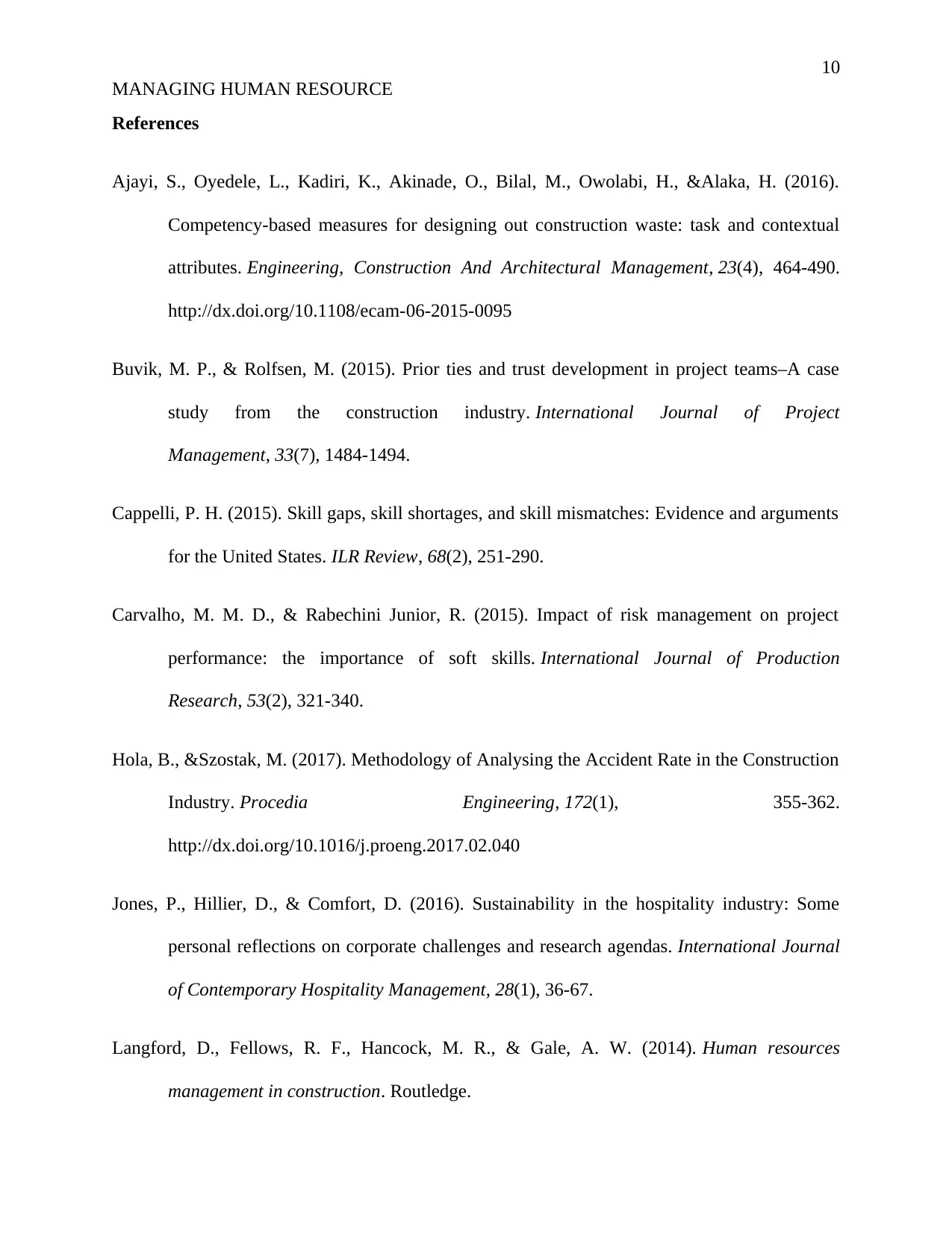
10
MANAGING HUMAN RESOURCE
References
Ajayi, S., Oyedele, L., Kadiri, K., Akinade, O., Bilal, M., Owolabi, H., &Alaka, H. (2016).
Competency-based measures for designing out construction waste: task and contextual
attributes. Engineering, Construction And Architectural Management, 23(4), 464-490.
http://dx.doi.org/10.1108/ecam-06-2015-0095
Buvik, M. P., & Rolfsen, M. (2015). Prior ties and trust development in project teams–A case
study from the construction industry. International Journal of Project
Management, 33(7), 1484-1494.
Cappelli, P. H. (2015). Skill gaps, skill shortages, and skill mismatches: Evidence and arguments
for the United States. ILR Review, 68(2), 251-290.
Carvalho, M. M. D., & Rabechini Junior, R. (2015). Impact of risk management on project
performance: the importance of soft skills. International Journal of Production
Research, 53(2), 321-340.
Hola, B., &Szostak, M. (2017). Methodology of Analysing the Accident Rate in the Construction
Industry. Procedia Engineering, 172(1), 355-362.
http://dx.doi.org/10.1016/j.proeng.2017.02.040
Jones, P., Hillier, D., & Comfort, D. (2016). Sustainability in the hospitality industry: Some
personal reflections on corporate challenges and research agendas. International Journal
of Contemporary Hospitality Management, 28(1), 36-67.
Langford, D., Fellows, R. F., Hancock, M. R., & Gale, A. W. (2014). Human resources
management in construction. Routledge.
MANAGING HUMAN RESOURCE
References
Ajayi, S., Oyedele, L., Kadiri, K., Akinade, O., Bilal, M., Owolabi, H., &Alaka, H. (2016).
Competency-based measures for designing out construction waste: task and contextual
attributes. Engineering, Construction And Architectural Management, 23(4), 464-490.
http://dx.doi.org/10.1108/ecam-06-2015-0095
Buvik, M. P., & Rolfsen, M. (2015). Prior ties and trust development in project teams–A case
study from the construction industry. International Journal of Project
Management, 33(7), 1484-1494.
Cappelli, P. H. (2015). Skill gaps, skill shortages, and skill mismatches: Evidence and arguments
for the United States. ILR Review, 68(2), 251-290.
Carvalho, M. M. D., & Rabechini Junior, R. (2015). Impact of risk management on project
performance: the importance of soft skills. International Journal of Production
Research, 53(2), 321-340.
Hola, B., &Szostak, M. (2017). Methodology of Analysing the Accident Rate in the Construction
Industry. Procedia Engineering, 172(1), 355-362.
http://dx.doi.org/10.1016/j.proeng.2017.02.040
Jones, P., Hillier, D., & Comfort, D. (2016). Sustainability in the hospitality industry: Some
personal reflections on corporate challenges and research agendas. International Journal
of Contemporary Hospitality Management, 28(1), 36-67.
Langford, D., Fellows, R. F., Hancock, M. R., & Gale, A. W. (2014). Human resources
management in construction. Routledge.
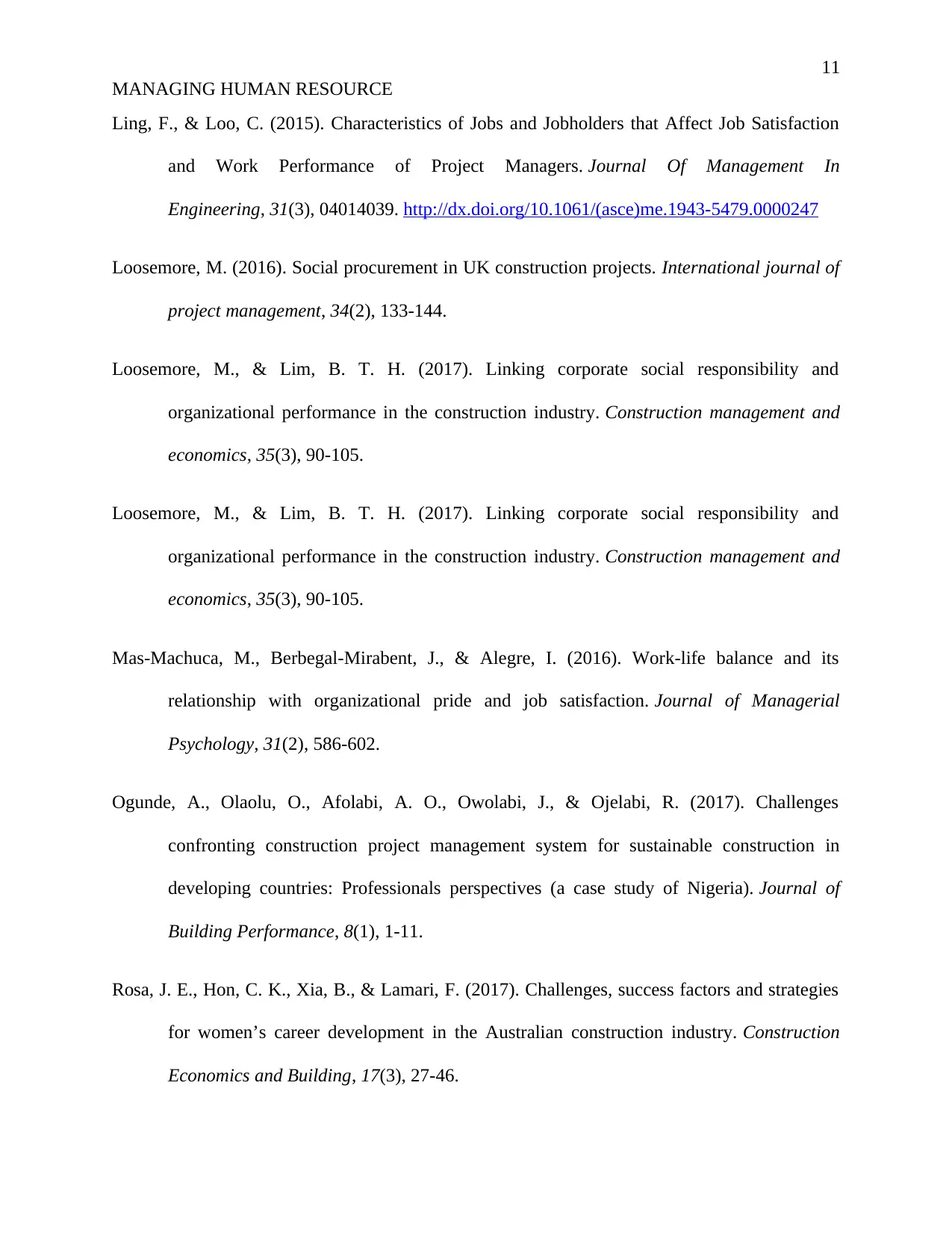
11
MANAGING HUMAN RESOURCE
Ling, F., & Loo, C. (2015). Characteristics of Jobs and Jobholders that Affect Job Satisfaction
and Work Performance of Project Managers. Journal Of Management In
Engineering, 31(3), 04014039. http://dx.doi.org/10.1061/(asce)me.1943-5479.0000247
Loosemore, M. (2016). Social procurement in UK construction projects. International journal of
project management, 34(2), 133-144.
Loosemore, M., & Lim, B. T. H. (2017). Linking corporate social responsibility and
organizational performance in the construction industry. Construction management and
economics, 35(3), 90-105.
Loosemore, M., & Lim, B. T. H. (2017). Linking corporate social responsibility and
organizational performance in the construction industry. Construction management and
economics, 35(3), 90-105.
Mas-Machuca, M., Berbegal-Mirabent, J., & Alegre, I. (2016). Work-life balance and its
relationship with organizational pride and job satisfaction. Journal of Managerial
Psychology, 31(2), 586-602.
Ogunde, A., Olaolu, O., Afolabi, A. O., Owolabi, J., & Ojelabi, R. (2017). Challenges
confronting construction project management system for sustainable construction in
developing countries: Professionals perspectives (a case study of Nigeria). Journal of
Building Performance, 8(1), 1-11.
Rosa, J. E., Hon, C. K., Xia, B., & Lamari, F. (2017). Challenges, success factors and strategies
for women’s career development in the Australian construction industry. Construction
Economics and Building, 17(3), 27-46.
MANAGING HUMAN RESOURCE
Ling, F., & Loo, C. (2015). Characteristics of Jobs and Jobholders that Affect Job Satisfaction
and Work Performance of Project Managers. Journal Of Management In
Engineering, 31(3), 04014039. http://dx.doi.org/10.1061/(asce)me.1943-5479.0000247
Loosemore, M. (2016). Social procurement in UK construction projects. International journal of
project management, 34(2), 133-144.
Loosemore, M., & Lim, B. T. H. (2017). Linking corporate social responsibility and
organizational performance in the construction industry. Construction management and
economics, 35(3), 90-105.
Loosemore, M., & Lim, B. T. H. (2017). Linking corporate social responsibility and
organizational performance in the construction industry. Construction management and
economics, 35(3), 90-105.
Mas-Machuca, M., Berbegal-Mirabent, J., & Alegre, I. (2016). Work-life balance and its
relationship with organizational pride and job satisfaction. Journal of Managerial
Psychology, 31(2), 586-602.
Ogunde, A., Olaolu, O., Afolabi, A. O., Owolabi, J., & Ojelabi, R. (2017). Challenges
confronting construction project management system for sustainable construction in
developing countries: Professionals perspectives (a case study of Nigeria). Journal of
Building Performance, 8(1), 1-11.
Rosa, J. E., Hon, C. K., Xia, B., & Lamari, F. (2017). Challenges, success factors and strategies
for women’s career development in the Australian construction industry. Construction
Economics and Building, 17(3), 27-46.
⊘ This is a preview!⊘
Do you want full access?
Subscribe today to unlock all pages.

Trusted by 1+ million students worldwide
1 out of 13
Related Documents
Your All-in-One AI-Powered Toolkit for Academic Success.
+13062052269
info@desklib.com
Available 24*7 on WhatsApp / Email
![[object Object]](/_next/static/media/star-bottom.7253800d.svg)
Unlock your academic potential
Copyright © 2020–2025 A2Z Services. All Rights Reserved. Developed and managed by ZUCOL.




